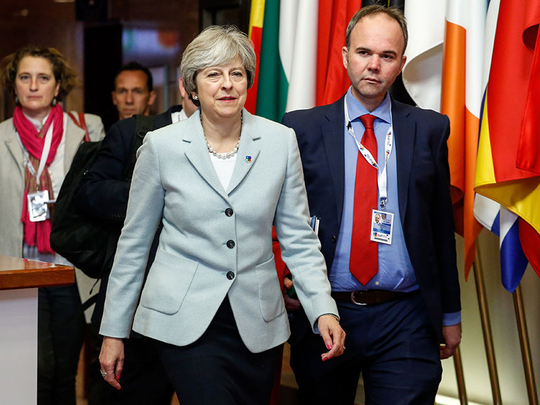
European leaders met on Friday at a summit of presidents and prime ministers with little progress on Brexit issues. The December Brexit deadline set by Brussels is now dominating UK politics and Prime Minister Theresa May is seeking desperately to break the negotiating logjam in coming days.
At stake is the critical question of whether second phase Brexit talks on the future UK-EU relationship can begin after the mid-December European Council meeting, the final big political calendar event of the EU political year. Or, if not, potentially be kicked out several months into 2018.
This crucial decision — on whether sufficient progress has been made in the first phase divorce talks — is one for EU’s 27 decision-makers alone to make underlining the in-built strengths of the bloc’s position in the two-year Article 50 process. If a breakthrough does not happen before mid-December, as now seems increasingly possible, prospects increase of no final deal and a hard, and potentially disorderly Brexit.
This is because any eventual second phase discussions on the future UK-EU relationship may be reduced to a matter of a handful of months. Chief EU negotiator Michel Barnier wants talks wrapped up by October 2018 to allow for any finalised agreement to be ratified before March 2019 when the two years of the Article 50 period end.
Despite half a dozen rounds of UK-EU negotiations since the summer, progress has been painstakingly slow on two of the key first phase divorce issues. That is, the UK’s financial exit bill, and the future status of the border between the Republic of Ireland (which will remain in the EU) and Northern Ireland (which will leave the Brussels-based club along with the rest of the UK).
European Parliament chief negotiator Guy Verhofstadt has recently described London’s positions on several Brexit issues, including the Irish border, as “fantasy”. More diplomatically, Barnier asserts that London is still failing to recognise fundamental issues like “frictionless trade is not possible outside the Single Market and Customs Union” given the EU’s commitment to the four freedoms of goods, capital, services and labour. Some of the rhetoric from Verhofstadt and Barnier is aimed at turning the screws on London in the negotiations, and EU decision makers need also to engage much more constructively. Yet, public infighting in the UK Cabinet has definitely sent signals this autumn that its Brexit plans are in disarray, and that it has still not reconciled many key negotiating ‘trade-offs’ by apparently wanting close, favourable post-Brexit ties without the costs.
To counter EU accusations of UK unpreparedness and failure to set out a clear enough vision for its planned exit, May has sought to seize the initiative, including with her September Florence speech. This has brought progress, including over the future of EU and UK citizen rights.
However, movement forward has been much trickier in other areas despite the flurry of Brexit negotiating position papers released in recent weeks on a wide array of issues. And May acknowledged last week that there is therefore still “a lot to be done”, especially over the Irish border issue, and the UK’s financial exit bill.
On the divorce bill, May made it clear on Friday she is willing to lay down extra money to try to meet the EU’s demands, but only if the bloc’s leaders can guarantee moving to stage two by widening talks to trade and the terms of a transition period. Highlighting the increasingly fraught nature of the process, May apparently feels she has been misled believing that Barnier’s team had made an agreement that movement forward could come here if she pledged, as she did in Florence, simply to honour future UK financial commitments made in the past.
However, this has ultimately solved little forcing the UK Cabinet this week to agree to move further on money on the proviso that the EU-27 guarantee in December progress to the second round of talks. Despite this though there is significant uncertainty whether an agreement can be reached in the next two weeks as numerous other EU member state leaders, including Angela Merkel, will need to consult their national parliaments.
On the Irish issue, the key question Dublin wants an answer to is how London will avoid a hard border being re-imposed between the Republic of Ireland and Northern Ireland. This is a major political headache, which could yet see an Irish veto, with Dublin favouring Belfast remaining in the European customs union which London appears to have dismissed as an option.
Given the political complexity and sensitivity of these and other issues, more constructive dialogue and pragmatism is now needed from both sides if breakthroughs are to be achieved by mid-December. There is some encouragement from the fact that the UK government appears slowly, but surely, to be opening the doors for compromise, and the EU must now seek to do the same otherwise it remains possible London could ultimately walk away from the talks.
Taken overall, significant distance still needs to be covered if UK-EU negotiations are not to go badly off track. With UK ministers doubling down on efforts to start second-phase talks after December’s European Council meeting, breakthroughs remain possible, but odds are otherwise growing of further delays which would tighten already tough timelines, increasing prospects of a hard, and potentially disorderly Brexit.
Andrew Hammond is an associate at LSE IDEAS at the London School of Economics.








